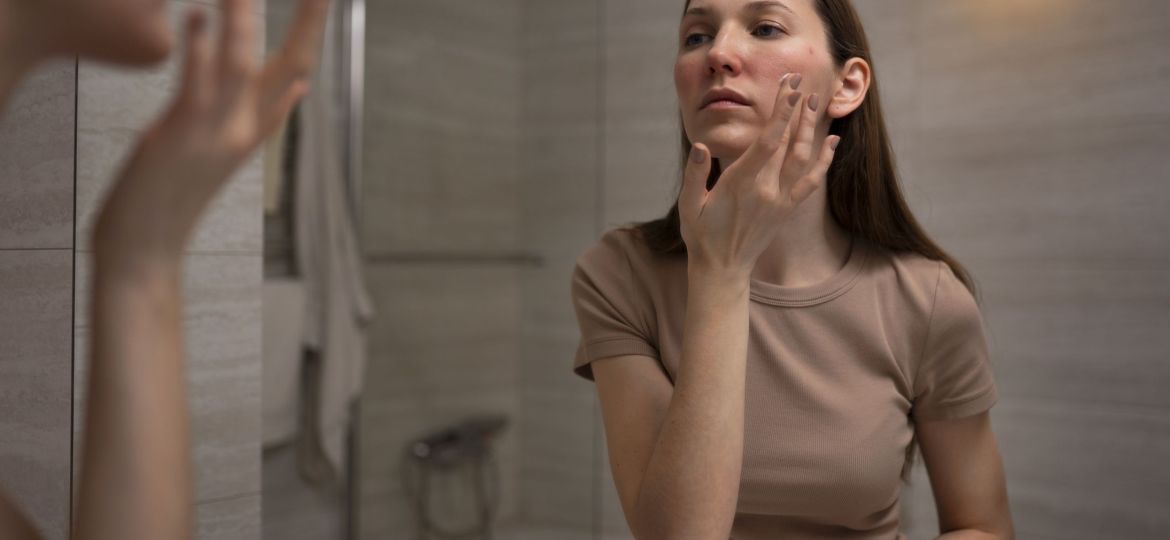
Some swear by the silky smooth results of dermaplaning, but is this viral skincare trend both effective and safe? Absolutely, if you visit a medical spa expert for your treatment. Read on to discover some dermaplaning misconceptions, potential not-so-ideal outcomes, and our best tips for avoiding any dermaplaning regrets.
What Is Dermaplaning?
Also known as “microplaning” or “blading,” dermaplaning is a professional skincare treatment that uses an exfoliating blade designed specifically for use on the skin. The procedure removes dead skin, product buildup, and vellus hairs (also known as peach fuzz) found on the cheeks and chin. Afterward, your skin should feel and look refreshed and smooth.
Renown Organics Regional Sales & Education Representative Tamara Hughes says that mistaking dermaplaning for shaving is a common mistake. “A dermaplaning treatment and shaving at home are completely different and use different tools to achieve different goals,” she explains. “Although they both use a blade that crosses the skin, that’s about all they have in common.”
“Despite the number of at-home blades available,” says Hughes, “dermaplaning should always be done by a qualified dermaplaning professional.”
Want a more detailed explanation of dermaplaning? Check out our guide to a dermaplane facial below.
How to Avoid Dermaplaning Regret
You might be wondering whether dermaplaning is “bad” for your skin. According to Healthline.com, dermaplaning can:
- Minimize the appearance of acne scars, imperfections, and fine lines.
- Give you a smooth and radiant skin tone after the treatment.
- Make makeup application and removal easier, as it provides a smoother canvas. Even skincare products can be applied more easily, with some believing that products absorb better into the skin.
Unlike laser hair removal and other aesthetic treatments, there is little to no recovery time, aside from ensuring you use sunscreen and limiting sun exposure. Since dermaplaning only affects the top few layers of skin, it is considered a minimally invasive treatment, involving less risk than other procedures. According to Hughes, freshly dermaplaned skin can be great for enhancing the results of chemical peel treatments, facials, and microneedling.
Is Dermaplaning Safe to Do at Home?
No! Always visit a spa for this treatment; never try it at home. In terms of results, they last about three weeks. Since your skin is in a vulnerable state afterward, it is at risk of sun damage in the days following the treatment. Due to the skin’s fragility, you should avoid using retinol or tingling skincare products for a couple of weeks after the treatment. Those with certain skin conditions (see below) should not attempt dermaplaning treatments.
Why Dermaplaning Should Only Be Done by an Esthetician
According to Hughes, dermaplaning is typically performed by a certified technician. This is because dermaplaning is a professional treatment that removes 2 to 3 weeks’ worth of dead skin cells and vellus hair. She explains the difference between professional dermaplaning and using a razor at home: “In the treatment, they use a surgical blade at a 45-degree angle for the primary purpose of exfoliating. In contrast, facial razors are tools that feature a safety guard and rest at a 35-degree angle and are designed for home use. Their main function is hair removal and ONLY removes the hair on the surface of the skin.”
Who Benefits from Dermaplaning?
Every skin type can potentially benefit from dermaplaning, and the technique can be particularly beneficial for those with:
- Acne scars and pockmarks
- Dull skin
- Dry skin
- Sun-damaged skin
- Fine wrinkles
- Concerns about vellus hair, which may thicken naturally due to age or conditions such as polycystic ovary syndrome.
Who Should Avoid Dermaplaning?
According to WebMD and Healthline.com, you should avoid dermaplaning if you have recently experienced or consistently suffer from:
- Severe sunburn
- Active breakouts
- Sensitive skin
- Use of Accutane or tretinoin in the past 6 months
- Cancer, or are undergoing cancer treatment
- Keloids
- Dermatitis
- Rosacea
- Spider veins
- Cystic acne
- Hirsutism
- Viruses such as chickenpox or shingles
Common Dermaplaning Regrets
Dermaplaning Regret #1: You “Wing It” and Try It at Home
It’s not difficult to find an at-home dermaplaning blade, but just because you can try dermaplaning at home doesn’t mean you should.
“Dermaplaning should always be done by a licensed dermaplaning professional to avoid injury and adverse reactions,” Hughes says. “Make sure to research certified technicians who have been trained in proper techniques. Be sure to read reviews and discuss the treatment with them before you begin.”
Without proper training, sterilization knowledge, or the skill to angle the tool correctly, you risk injuring the delicate skin on your face, which could lead to infection, irritation, scratches, or even scarring.
YouTuber Natalies Outlet discusses her disappointment after dermaplaning with an old blade, describing the results as feeling like “ingrown hairs.” “I had bumps for months,” she says in her video.
Dermaplaning Regret #2: Your Breakouts Worsen
According to the Cleveland Clinic, the sweeping motion of dermaplaning can make breakouts worse by spreading bacteria around. Over time, this can even cause more breakouts and aggravate existing acne. We always recommend avoiding dermaplaning if you’re dealing with acne, active breakouts, or using acne treatments like Accutane or Isotretinoin. However, if you believe your skin is clear enough to try the technique, make sure you’re working with a professional to keep dermaplaning tools away from any damaged skin or imperfections.
Dermaplaning Regret #3: Dermaplaning Irritates Your Skin
Although you might initially feel thrilled with the smoothness, a few hours later, your skin may feel tight and irritated if dermaplaning has been too harsh for your delicate skin. We always recommend consulting with your dermaplaning specialist or dermatologist before the treatment to discuss whether it’s right for you.
If your skin only occasionally experiences sensitivity, consider an oil-planning treatment that applies a layer of facial oil to the skin before dermaplaning to reduce friction. Always remember that your treatment should be slow, careful, and very light on the skin to avoid scratching or irritation.
Dermaplaning Regret #4: It Reactivates an Old Cold Sore
Unfortunately, dermaplaning the wrong area can awaken an old cold sore, reactivating the herpes simplex virus on your skin. To prevent this, consult a doctor to secure an oral anti-herpes medication or antibiotic to prevent any outbreaks, and always let your skin expert know about your cold sore history before your treatment.
Dermaplaning Regret #5: Ignoring Your Skin After Treatment
Since dermaplaning removes a layer of older skin to reveal a fresh one, a restorative regimen is essential in the weeks following your treatment. Skin cells in the epidermis take about two weeks to turn over, so follow your dermaplaning facial treatment with a routine that replenishes the skin barrier to maintain smooth, healthy skin long term.
This means focusing on:
- Hydrating serums and hyaluronic acids to add moisture to the skin
- Hydrating in the weeks following the treatment
- Sunscreen, as your skin is more vulnerable to UV damage
- Avoiding skincare products that cause your skin to tingle
- Avoiding retinol
- Gentle cleansing
With proper care and professional assistance, dermaplaning refreshes the skin and leaves it looking perfectly smooth.
